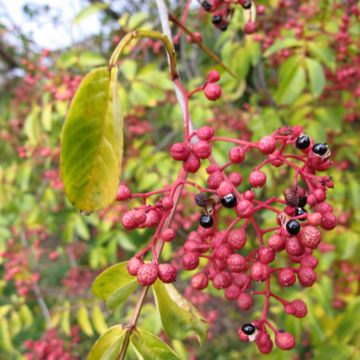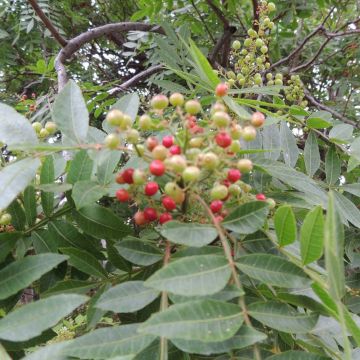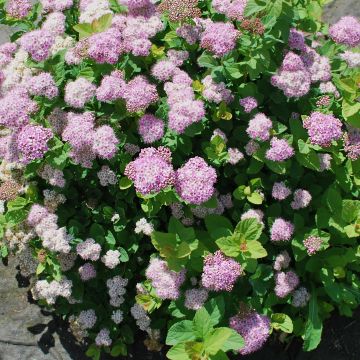

Zanthoxylum piperitum Black Magic - Poivrier du Japon


Zanthoxylum piperitum Black Magic - Poivrier du Japon


Zanthoxylum piperitum Black Magic - Poivrier du Japon


Zanthoxylum piperitum Black Magic - Poivrier du Japon
Zanthoxylum piperitum Black Magic
Zanthoxylum piperitum Black Magic (Purple Leaves)
Sichuan Pepper, Japanese Pepper, Korean Pepper, Sansho, Japanese Prickly Ash
Planting in October 2020. Dead aerial parts during winter. New shoot in spring of 15cm (6in) which eventually died. Response from Promesse de Fleurs. Sorry for the failure to revive your plant, contact us at 0361760810 for replacement or refund. Kind regards.
Fabien, 04/09/2021
Why not try an alternative variety in stock?
View all →This plant carries a 24 months recovery warranty
More information
We guarantee the quality of our plants for a full growing cycle, and will replace at our expense any plant that fails to recover under normal climatic and planting conditions.
From €5.90 for pickup delivery and €6.90 for home delivery
Express home delivery from €8.90.
Does this plant fit my garden?
Set up your Plantfit profile →
Description
The Zanthoxylum piperitum 'Black Magic' is a rare form of the Sichuan Pepper, highly sought after by collectors: its delicate fern-like leaves are remarkably coloured in shiny chocolate-purple. Like its Asian ancestors, sometimes called Clavalier, this bush has remarkably aromatic foliage, but unlike its ancestors, it does not produce aromatic fruits. The combination of small flowers and foliage taking on shades of golden purple in autumn is superb in this Chinese pepper tree that will be decorative 9 months out of 12. Fantastic as a stand-alone, it is also ideal as a free hedge, and its young, thorny branches are lovely in a defensive hedge.
Native to the Sichuan province, located in southwest China, the Zanthoxylum piperitum is widely spread from Japan to Vietnam. It is part of the same family as citrus trees, the Rutaceae family, with which it shares a highly aromatic foliage. Zanthoxylum is a group of plants that look very similar, making them tricky to tell apart. People usually use things like how many leaves they have or what the flowers and thorns look like to figure out which one is which. This large bush loses its foliage in winter, occasionally withstands -18°C (1°F) and develops in well-draining and sufficiently deep soil. Late frosts can, however, harm flowering and burn its young shoots. The Chinese pepper tree is extremely tenacious and can grow in any condition except for dense shade.
Growing quickly in moist and fertile soil, this 'Black Magic' pepper tree measures an average of 3m (10ft) in height with a similar spread at maturity. Its habit is elegant, naturally bushy and spreading, supported by flexible branches. The trunk and young branches are adorned with flat thorns that broaden significantly at the base over the years while their tips become blunt. They eventually form curious growths that resemble large warts. The branches, of a brown-purple colour, bear leaves arranged alternately, 7 to 15 cm (3 to 6in) long, divided into 11 to 23 small ovate and glossy leaflets, toothed at the edges, producing essential oils and small barbs. When crushed, they emit a scent that is spicy, woody, lemony, and slightly peppery but mild. Their colour successively changes from purple-violet to dark green, and then they take on yellow, orange, and pink-purple hues in autumn before falling. The flowering already appears on 3 or 4-year-old plants (since sowing). It occurs in May-June, more or less early depending on the climate, on one-year-old branches. It consists of small clusters or cymes about 3 to 5 cm (1 to 2in) in diameter, composed of small cup-shaped flowers in a yellow-green colour. This selection only has male flowers, so the plant cannot produce fruit.
This beautiful bush, with its fascinating foliage and unusual bark, deserves a special place. It can grow into a beautiful tree if planted in isolation. You can trim the lower branches up to 1 metre (3 feet) from the ground to reveal its tall, bare trunk. Alternatively, it can be planted in an untrimmed hedge alongside other plants such as dogwoods, rowans, viburnums, Osage oranges, ornamental apple and cherry trees, or honey locusts.
The Zanthoxylum has thorny young branches, making it an excellent choice for a defensive hedge. You can combine it with Poncirus trifoliata, Rosa moyesii, Japanese quince Cido, seabuckthorn, and more to create a defensive hedge.
Report an error about the product description
Zanthoxylum piperitum Black Magic in pictures




Plant habit
Flowering
Foliage
Botanical data
Zanthoxylum
piperitum
Black Magic (Purple Leaves)
Rutaceae
Sichuan Pepper, Japanese Pepper, Korean Pepper, Sansho, Japanese Prickly Ash
China
Other Zanthoxylum - Prickly Ash
Planting and care
If you want to grow the 'Black Magic' Sichuan pepper plant, it's best to do it during spring in cooler climates or early autumn in drier and hotter climates. When choosing a location, ensure it's sheltered from cold and dry winds that could damage the plant's flowers and young shoots. The plant likes sunny locations and well-drained soils that are deep and fertile. It can tolerate soil with clay and limestone and acidic soils that are not too poor. If you keep the soil slightly moist in summer, it will grow quickly. Once the plant is established, it can survive without watering in summer, except in hot and dry climates. It's resistant to -18°C (1°F) but is more sensitive to frost in its young years, especially in heavy and humid soil. To make the soil lighter, you can add river sand, gravel, or pumice. In very cold regions, you should protect young plants with winter coverings and mulch the base.
The Chinese pepper plant is easy to grow and requires little maintenance. If you're planting it in a free hedge, it's recommended to plant one every metre. It's not susceptible to any specific diseases or pests in gardens. To protect young plants from herbivores like rabbits, you can use a fence if the area is not enclosed. When pruning the plant, it's best to avoid doing it in autumn, as this will sacrifice the following spring's flowering.
Planting period
Intended location
Care
-
, onOrder confirmed
Reply from on Promesse de fleurs
Hedge shrubs
Haven't found what you were looking for?
Hardiness is the lowest winter temperature a plant can endure without suffering serious damage or even dying. However, hardiness is affected by location (a sheltered area, such as a patio), protection (winter cover) and soil type (hardiness is improved by well-drained soil).

Photo Sharing Terms & Conditions
In order to encourage gardeners to interact and share their experiences, Promesse de fleurs offers various media enabling content to be uploaded onto its Site - in particular via the ‘Photo sharing’ module.
The User agrees to refrain from:
- Posting any content that is illegal, prejudicial, insulting, racist, inciteful to hatred, revisionist, contrary to public decency, that infringes on privacy or on the privacy rights of third parties, in particular the publicity rights of persons and goods, intellectual property rights, or the right to privacy.
- Submitting content on behalf of a third party;
- Impersonate the identity of a third party and/or publish any personal information about a third party;
In general, the User undertakes to refrain from any unethical behaviour.
All Content (in particular text, comments, files, images, photos, videos, creative works, etc.), which may be subject to property or intellectual property rights, image or other private rights, shall remain the property of the User, subject to the limited rights granted by the terms of the licence granted by Promesse de fleurs as stated below. Users are at liberty to publish or not to publish such Content on the Site, notably via the ‘Photo Sharing’ facility, and accept that this Content shall be made public and freely accessible, notably on the Internet.
Users further acknowledge, undertake to have ,and guarantee that they hold all necessary rights and permissions to publish such material on the Site, in particular with regard to the legislation in force pertaining to any privacy, property, intellectual property, image, or contractual rights, or rights of any other nature. By publishing such Content on the Site, Users acknowledge accepting full liability as publishers of the Content within the meaning of the law, and grant Promesse de fleurs, free of charge, an inclusive, worldwide licence for the said Content for the entire duration of its publication, including all reproduction, representation, up/downloading, displaying, performing, transmission, and storage rights.
Users also grant permission for their name to be linked to the Content and accept that this link may not always be made available.
By engaging in posting material, Users consent to their Content becoming automatically accessible on the Internet, in particular on other sites and/or blogs and/or web pages of the Promesse de fleurs site, including in particular social pages and the Promesse de fleurs catalogue.
Users may secure the removal of entrusted content free of charge by issuing a simple request via our contact form.
The flowering period indicated on our website applies to countries and regions located in USDA zone 8 (France, the United Kingdom, Ireland, the Netherlands, etc.)
It will vary according to where you live:
- In zones 9 to 10 (Italy, Spain, Greece, etc.), flowering will occur about 2 to 4 weeks earlier.
- In zones 6 to 7 (Germany, Poland, Slovenia, and lower mountainous regions), flowering will be delayed by 2 to 3 weeks.
- In zone 5 (Central Europe, Scandinavia), blooming will be delayed by 3 to 5 weeks.
In temperate climates, pruning of spring-flowering shrubs (forsythia, spireas, etc.) should be done just after flowering.
Pruning of summer-flowering shrubs (Indian Lilac, Perovskia, etc.) can be done in winter or spring.
In cold regions as well as with frost-sensitive plants, avoid pruning too early when severe frosts may still occur.
The planting period indicated on our website applies to countries and regions located in USDA zone 8 (France, United Kingdom, Ireland, Netherlands).
It will vary according to where you live:
- In Mediterranean zones (Marseille, Madrid, Milan, etc.), autumn and winter are the best planting periods.
- In continental zones (Strasbourg, Munich, Vienna, etc.), delay planting by 2 to 3 weeks in spring and bring it forward by 2 to 4 weeks in autumn.
- In mountainous regions (the Alps, Pyrenees, Carpathians, etc.), it is best to plant in late spring (May-June) or late summer (August-September).
The harvesting period indicated on our website applies to countries and regions in USDA zone 8 (France, England, Ireland, the Netherlands).
In colder areas (Scandinavia, Poland, Austria...) fruit and vegetable harvests are likely to be delayed by 3-4 weeks.
In warmer areas (Italy, Spain, Greece, etc.), harvesting will probably take place earlier, depending on weather conditions.
The sowing periods indicated on our website apply to countries and regions within USDA Zone 8 (France, UK, Ireland, Netherlands).
In colder areas (Scandinavia, Poland, Austria...), delay any outdoor sowing by 3-4 weeks, or sow under glass.
In warmer climes (Italy, Spain, Greece, etc.), bring outdoor sowing forward by a few weeks.


















































